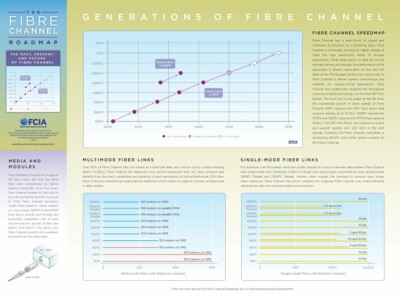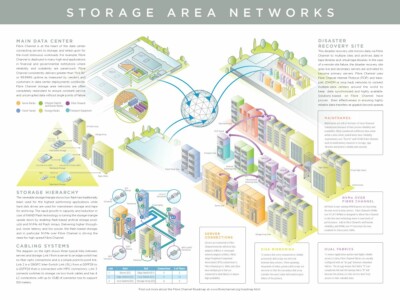The Fibre Channel Roadmap illustrates the physical layer of Fibre Channel. The roadmap shows the historic speeds and feeds of Fibre Channel and the future speeds up to Terabit Fibre Channel (TFC). The map also shows how Fibre Channel is used in data centers to create storage area networks.
The Fibre Channel Roadmap consists of:
Fibre Channel Speedmap v24 (updated July, 2023)
| Fibre Channel Speed Roadmap — FC | ||||
| Product Naming | Throughput (Mbytes/s)* |
Line Rate (GBaud) |
T11 Spec Technically Completed (Years)‡ |
Market Availability (Years)‡ |
| 8GFC | 1600 | 8.5 NRZ | 2006 | 2008 |
| 16GFC | 3200 | 14.025 NRZ | 2009 | 2011 |
| 32GFC | 6400 | 28.05 NRZ | 2013 | 2016 |
| 64GFC | 12800 | 28.9 PAM-4 | 2017 | 2020 |
| 128GFC | 24850 | 56.1 PAM-4 | 2022 | 2024 |
| 256GFC | 49700 | 112.2 PAM-4 | 2025 | Market Demand |
| 512GFC | TBD | TBD | 2029 | Market Demand |
| 1TFC | TBD | TBD | 2033 | Market Demand |
“FC” used throughout all applications for Fibre Channel infrastructure and devices, including edge
and ISL interconnects. Each speed maintains backward compatibility at least two previous generations
(I.e., 32GFC backward compatible to 16GFC and 8GFC)
* These numbers are representative of throughput values for the line rate and are payload dependent.
‡ Dates: Future dates estimated
| Fibre Channel Speed Roadmap — Inter-Switch Link | ||||
| Product Naming | Throughput (Mbytes/s)* |
Line Rate (Gbaud)† |
T11 Spec Technically Completed (Years)‡** |
Market Availability (Year)‡ |
| 10GFC | 2400 | 10.52 NRZ | 2003 | 2009 |
| 128GFC | 25600 | 4X28.05 NRZ | 2014 | 2016 |
| 256GFC | 51200 | 4X28.9 PAM-4 | 2018 | 2020 |
ISLs are usually multi-lane interconnects used for non-edge, core connections, and other high speed applications demanding maximum bandwidth.
ISL’s utilize high bit-rates to accommodate the funneling of edge connections. Some ISL solutions are vendor-proprietary.
*These numbers are representative throughput values for the line rate and are payload dependent.
† Equivalent Line Rate: Rates listed are equivalent data rates for serial stream methodologies.
‡ Dates: Future dates estimated
**FCoE standard completion date is the completion of the Ethernet standard











